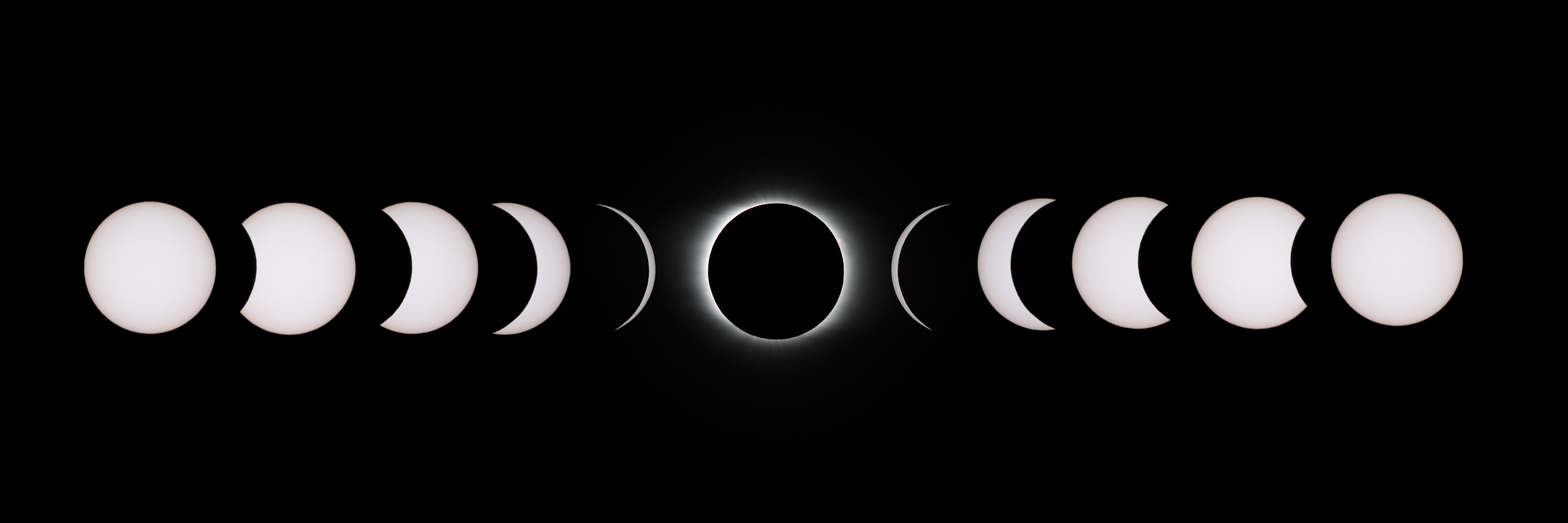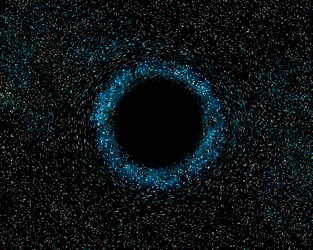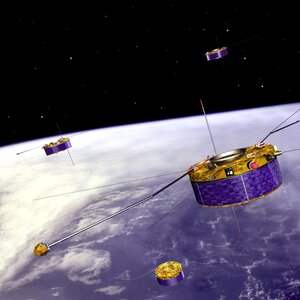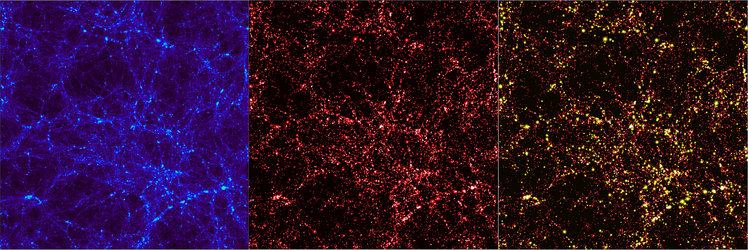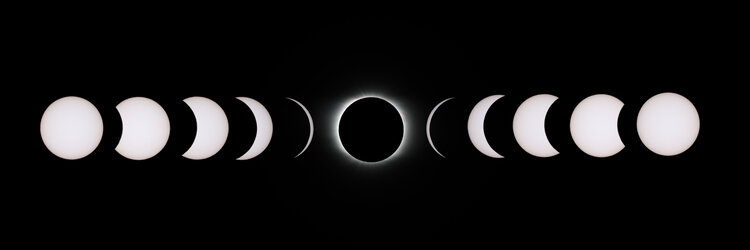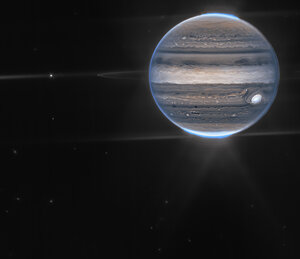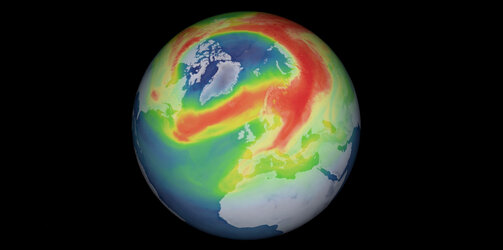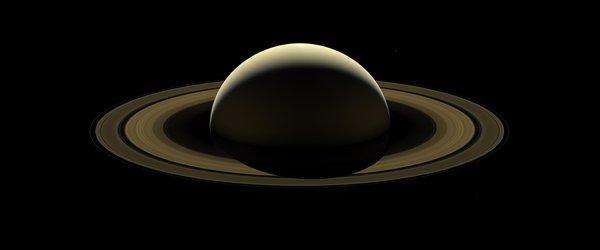E
Earth
The third of the four terrestrial planets counting out from the Sun. The distance between Earth and the Sun is 1 astronomical unit (about 150 million km).
Eclipse, solar
When Earth enters the Moon's shadow as the Moon moves wholly (total eclipse) or partially (partial eclipse) in front of the Sun as seen from Earth.
Eclipse, lunar
When the Moon enters the Earth's shadow as the Earth moves between the Sun and the Moon.
Ecliptic plane
The plane of Earth's orbit and the planets' orbit around the Sun. Projected onto the celestial sphere it is the path the Sun takes across the sky and because it is the plane of the Solar System, the planets always stay close to it in their passages across the sky.
Effective area
The unrestricted collecting area of a telescope after obstructions in the optical path have been taken into account.
Einstein Cosmological Constant (lambda)
The value of a supposed repulsion force that would contribute to the expansion of the Universe. It was first predicted by Einstein in 1917 to avoid one of the results of his own equations, which implied that the Universe would collapse one day under its own gravity. At that time the Universe was thought to be static. When the observations proved that the Universe is actually expanding, Einstein said that the cosmological constant had been his biggest error. However, some physicists believe today that there is indeed such a repulsion force in the Universe.
Electric propulsion
Advanced propulsion system, as used on certain satellites (SMART-1), employing solar electric power to ionise and expel a propellant (such as Xenon gas) at high speed, causing it to move forwards. Compared with conventional chemical propulsion systems, electric propulsion requires less propellant to perform similar operations.
Electromagnetic radiation
Electromagnetic radiation, or light, can be considered to be composed of particles (photons) or waves. Its properties depend on its wavelength: longer waves are less energetic than shorter waves – photons with long wavelength have less energy than short-wavelength photons. Electromagnetic radiation is usually described as bands of radiation of similar wavelength, e.g., infrared, radio waves, microwaves, gamma rays, X-rays... (These bands of radiation roughly correspond to the range of wavelengths which can be detected by different instruments.) Only a small fraction of the entire range of electromagnetic radiation can be detected by the human eye: visible light, or what in everyday-life is referred to simply as light. The human eye cannot detect wavelengths longer than those of the visible light, such as those of infrared light, microwaves (wavelengths of centimetres), or radio waves (wavelengths of metres). Wavelengths shorter than visible light cannot be seen either: ultraviolet light, X-rays, gamma rays (the most energetic). Electromagnetic radiation can be described in terms of wavelength (L), measured in metres (m), or frequency (f), measured in hertz (Hz). The relationship between these two is given by: f = L/c where c= speed of light.
Electromagnetic spectrum
The electromagnetic spectrum is the complete range of wavelengths of the electromagnetic radiation.
Electron
A fundamental physical particle with negative charge. A component of atoms.
Electron-positron annihilation
When an electron and its anti-particle, a positron, collide, they annihilate emitting a pair of gamma-ray photons each with an energy of 511 keV.
Electronvolt (eV)
Unit of energy defined as the energy acquired by an electron in falling through a potential difference of one volt. Electronvolts are used as a measure of the energy of cosmic rays and high-energy photons. For example, X-rays can have energies of 1000 eV (1 keV) or more.
Element
Set of stable atoms from which all known molecules are made out. These atoms are organised as a function of their chemical properties in the so-called 'Periodic Table of the Elements'.
Elliptical orbit
An orbit which describes an ellipse or oval shape.
Emission
The release of electromagnetic radiation (e.g., light, X-rays, gamma rays) from excited atoms or molecules.
Energy
The capacity of a body or system to do work. In the metric measurement system, the unit of energy is the Joule, which is the work produced by a force of 1 Newton moving over a distance of 1 metre.
European Space Agency (ESA)
An intergovernmental organisation with a mission to provide and promote – for exclusively peaceful purposes – the exploitation of space science, research & technology, and space applications. The 18 ESA Member States are: Austria, Belgium, Czech Republic, Denmark, Finland, France, Germany, Greece, Ireland, Italy, Luxembourg, Norway, the Netherlands, Portugal, Spain, Sweden, Switzerland and the United Kingdom.
Escape velocity
The minimum speed needed to escape the gravitational attraction of a celestial body and enter space. Earth's escape velocity is 11.2 km/s.
Ethane
A colourless and odourless gas that belongs to the alkane series of the hydrocarbons.
Exobiology
The study of biological processes that have or could have evolved away from Earth.
Extinction
Reduction in the intensity of electromagnetic radiation received from a celestial body (e.g. a star) as a result of scattering and absorption by intervening material (e.g. dust).
Extragalactic
Outside of our Galaxy.
Extravehicular
Outside the spacecraft; activity in space conducted by astronauts (EVA = extravehicular activity).
Extreme ultraviolet (EUV)
Region of the spectrum between the ultraviolet and X-ray regions covering wavelengths between 10-100 nm.















 Germany
Germany
 Austria
Austria
 Belgium
Belgium
 Denmark
Denmark
 Spain
Spain
 Estonia
Estonia
 Finland
Finland
 France
France
 Greece
Greece
 Hungary
Hungary
 Ireland
Ireland
 Italy
Italy
 Luxembourg
Luxembourg
 Norway
Norway
 The Netherlands
The Netherlands
 Poland
Poland
 Portugal
Portugal
 Czechia
Czechia
 Romania
Romania
 United Kingdom
United Kingdom
 Slovenia
Slovenia
 Sweden
Sweden
 Switzerland
Switzerland

























